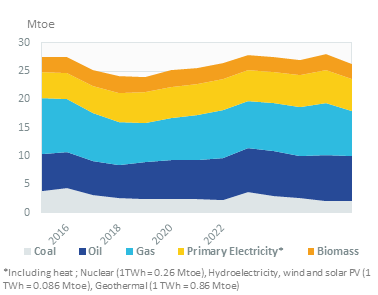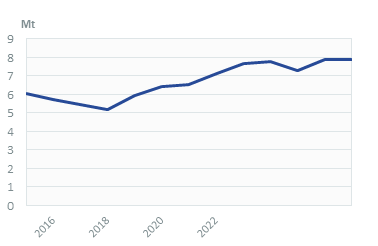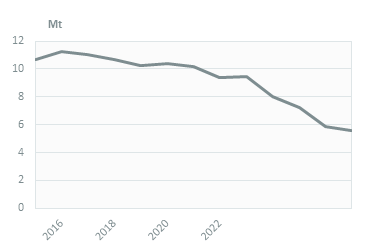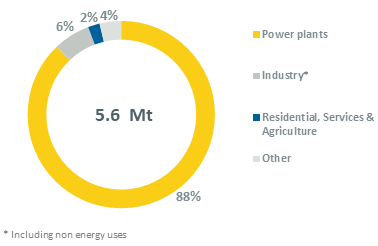-
-
 Energy and Climate Databases
Energy and Climate Databases- The most comprehensive and up-to-date annual energy database.
- Monitoring of technology providers in H2 supply chain.
- Monthly energy data on key energy markets.
- The most reliable and up-to-date power generation database.
- The essentials of LNG trade at your fingertips.
- Global monitoring of new and existing refineries.
- Analyse energy consumption and efficiency trends at world level. Benchmark countries.
- Have your database developed by a recognised expert of both energy and IT.
-
 Energy - Climate Forecasts
Energy - Climate Forecasts- Instant access to energy and emissions forecasts.
- Strategic, annual wholesale price projections backed by Enerdata's energy modelling expertise and our globally recognised POLES model.
- Wedges module showing a breakdown of the levers enabling to reduce emissions between two scenarios.
- Unique, independent projections of consumption by end-use.
- GHG Marginal Abatement Cost Curves.
- Benefit from proven models to draw your own energy scenarios and anticipate tomorrow’s challenges.
-
 Market Intelligence
Market Intelligence- 110 Energy and climate country reports
- A newsletter to receive the latest updates on evolving technologies and policies.
- Global energy news and analyses curated daily.
- Enerdata’s experts bring you the essentials about your market and competitors.
-
-
-
 Market Analysis
Market Analysis- Understanding key consumption trends and drivers across sectors.
- Granular and exclusive insight to address the most pressing business and strategic issues.
- Expertise in strategic and business intelligence, with fine-tuning to the market’s specificities.
-
 Energy - Climate Scenarios
Energy - Climate Scenarios- Providing the outlook of an energy commodity in mid to long term time horizons.
- Sector and driver specific energy demand forecasting.
- Assess the evolution of energy prices on the international and regional markets, as well as end-users prices.
- Enerdata guides you through pathways to reach climate targets.
- Supporting local authorities in their decarbonisation strategies.
-
 Climate Strategy and Policy Evaluation
Climate Strategy and Policy Evaluation- Cutting-edge quantitative tools and relevant indicators to monitor and evaluate evolutions on worldwide energy markets.
- Analysis of the most cost-effective options to reduce emissions.
- Quantified simulation and analysis of pledges for climate change negotiations.
- Breakdown and analysis of carbon markets.
- Enerdata guides you on the most beneficial policy or investment options.
- Turning climate objectives into concrete action plans.
-
 Training
Training- Understand different policy targets and measures on energy efficiency.
- How to measure energy savings?
- Energy Forecasting is a 2 days training to learn to design and interpret energy forecasts.
- Energy statistics training allowing to create energy balance with supply, transformation and consumption and understanding the international energy statistics regulations.
- Initiation to EnerMED level 1is the training to approach on the most powerful energy demand forecasting model.
-
-
Resource Centre
Hungary Key Figures
- Population:
- 9.71 million
- GDP growth rate:
- 4.90 %/year
- Energy independence:
- 43.2%
Data of the last year available: 2022
- Total consumption/GDP:*
- 67.2 (2005=100)
- CO2 Emissions:
- 4.60 tCO2/capita
- Rate of T&D power losses:
- 6.06%
* at purchasing power parity
View all macro and energy indicators in the Hungary energy report
Hungary Related News
View all news, archive your new and create your own daily newsletters only on your topics/countries of interest with Key Energy Intelligence
Hungary Related Research
Benefit from up to 2 000 up-to-date data series for 186 countries in Global Energy & CO2 data
A data overview is available in the global energy statistics app
Total Energy Consumption
Energy consumption per capita is 2.7 toe (13% below the EU average), including 4400 kWh of electricity (8% below the EU27 average) (2022).
Total energy consumption decreased by 6% in 2022, after a 4% rebound in 2021. It decreased by 1.7%/year from 2018 to 2020 after a period of rapid growth between 2014 and 2018 (+4%/year).
Graph: CONSUMPTION TRENDS BY ENERGY SOURCE (Mtoe)

Interactive Chart Hungary Total Energy Consumption
Benefit from up to 2 000 up-to-date data series for 186 countries in Global Energy & CO2 data
View the detailed fondamentals of the market at country level (graphs, tables, analysis) in the Hungary energy report
Crude Oil Production
Oil production, which is distributed over 6 production sites, covers around 16% of the country's needs (1.1 Mt in 2022). In 2021, Russia was the main oil supplier (41%), followed by Kazakhstan (12%) and Austria (11%)
The country has one refinery, the Szazhalombatta refinery of MOL, with a capacity of 162 kb/d (8.1 Mt/year), that processed 7.2 Mt in 2021. MOL closed its Zala refinery in 2001 (10 kb/d) and Tisza refinery (61 kb/d in 2008).
Interactive Chart Hungary Crude Oil Production
Benefit from up to 2 000 up-to-date data series for 186 countries in Global Energy & CO2 data
Additionally, for more detailed information on refineries, you can request a sample of our EMEA Refineries Dataset
Oil Products Consumption
Oil consumption increased by 9% in 2021 and remained stable in 2022 (7.8 Mt). It rose very rapidly between 2013 and 2019 (by 5.5%/year),
The bulk of oil products is consumed in the transport sector (59% in 2022), followed by industry (30%), especially for non-energy uses.
Graph: OIL CONSUMPTION (Mt)

Graph: OIL CONSUMPTION BREAKDOWN BY SECTOR (2022, %)
Interactive Chart Hungary Refined Oil Products Production
Benefit from up to 2 000 up-to-date data series for 186 countries in Global Energy & CO2 data
Additionally, for more detailed information on refineries, you can request a sample of our EMEA Refineries Dataset
Natural Gas Consumption
Gas consumption dropped by 15% in 2022 to 9.7 bcm, whereas it increased rapidly between 2014 and 2019, by 3.5%/year on average. It fell rapidly between 2005 and 2014 (by 5.6%/year).
Almost half of the gas is consumed by households and services (47% in 2022). The share of industry in gas consumption has increased since 2010, from 18% to 25% in 2022 (including non-energy uses), a share higher than that of the power sector (22%). However, due to rising gas prices for industrial, the share of gas consumption of industry (excluding non-energy uses) dropped by 19% in 2022.
Interactive Chart Hungary Natural Gas Domestic Consumption
Benefit from up to 2 000 up-to-date data series for 186 countries in Global Energy & CO2 data
Additionally, for more detailed information on the LNG trade, you can request a sample of our EMEA LNG Trade Dataset
Coal Consumption
Coal and lignite consumption has collapsed since 1990, from 22 Mt to 5.6 Mt, in line with the demand from power plants, as most of the coal and lignite is used in the power sector (88%).
Graph: COAL CONSUMPTION (Mt)

Graph: COAL CONSUMPTION BREAKDOWN BY SECTOR (2022, %)

Interactive Chart Hungary Coal and Lignite Domestic Consumption
Benefit from up to 2 000 up-to-date data series for 186 countries in Global Energy & CO2 data
View the detailed consumption trends at country level (graphs, tables, analysis) in the Hungary energy report
Power Consumption
Electricity consumption decreased by 2% in 2022 to 42.7 TWh, after a 5% rebound in 2021. Electricity consumption rose quite rapidly between 2014 and 2019 (+2.6%/year) and remained stable in 2020 (41 TWh in 2020); it was relatively stable between 2008 and 2014.
The share of electricity consumed in industry has increased from 25% in 2007 to 43% (2022). Households and services account for 30% and 19%, respectively, of the electricity consumption.
Graph: ELECTRICITY CONSUMPTION (TWh)
Renewable in % Electricity Production
The national target of a 14.65% share of renewables in the final energy consumption in 2020 was missed by 0.5 pp as the country reached 13.9%. However, the EU Directive target of 13% was met.
The National Energy and Climate Plan set a target of 21% of renewables in final energy consumption by 2030, of which 21% for electricity, 29% for heating and cooling, and 17% in transport. In 2021, this share reached 14% (13.7% of which for electricity, 17.9% for heating, and 6.2% for transport
Interactive Chart Hungary Share of Renewables in Electricity Production (incl hydro)
Benefit from up to 2 000 up-to-date data series for 186 countries in Global Energy & CO2 data
Learn more about renewables in the European Battery Market Analysis
CO2 Fuel Combustion/CO2 Emissions
GHG emissions increased by 2% in 2021 to 57 MtCO2eq, after a 6% drop in 2020 and a 1% decline in 2019. They increased by 3%/year over 2014-2018 and were 38% below their 1990 level in 2021.
In 2020, the parliament adopted a law to achieve carbon neutrality by 2050. In the medium term, the country is committed to a binding GHG emission reduction target of at least 40% by 2030 compared to 1990, as in other EU countries.